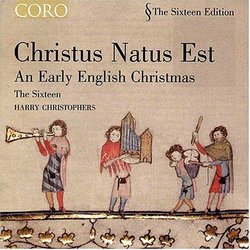Superb renditions of Christmas music - (mainly) without the
Maddy Evil | London, UK | 01/08/2006
(5 out of 5 stars)
"Amongst the exhaustive catalogue of recordings devoted to Christmas music, this particular example - focusing on works written in England during the Middle Ages and Renaissance - can be warmly recommended indeed. The performances, as ever by this superb choir, are polished and beautifully executed, and the programme is varied both in terms of the selection of pieces (carols, motets, ballads, chant...) and also in the interpretations (usually choir or consort but sometimes 1 singer, occasionally accompanied by instruments - harp, lute, rebec/fiddle, drums). In fact, several tracks are arguably the best performances currently available of the pieces in question (especially tracks 4, 9, 11 and 12).
From a purely academic viewpoint, however, there are some musicological inaccuracies, amongst which the most apparent is probably the use of sopranos (although the Sixteen are by no means alone in this, and it's easy to see why - given the accuracy of intonation and ensemble achieved by mixed-voice choirs - so many of the best recordings of early choral music use women in favour of boy trebles). Texts and pronunciation are also modernised (e.g. in place of 'Swete was the Song the Virgine soong', etc.) which arguably removes something of the original character of the songs, particularly in cases where the intended rhyming structure of the poetry is distorted (as in 'Ther is no rose of swych vertu', where the words 'was' and 'space' [verse 2] were almost certainly pronounced using the same vowel sound in 15th-century English). Thirdly, some of the transcriptions are also problematic, either because they combine differing manuscript sources, with no indication of this in the notes (like tracks 4 and 17), or, as in the case of 'Gaudete!', because they do not consider problems associated with ficta (sources contemporaneous with Piae Cantiones [1582], including other extant versions of 'Gaudete!', indicate that use of accidentals was much more widespread than often acknowledged). Lastly, there are some philological anomalies, such as in the erroneous attribution of 'c.1600 Playford MS' for tracks 14 and 16 (John Playford [c.1623-86] was not even born...!!). Presumably (at least for track 14), the manuscript being referred to is the broadside ballad 'A pleasant Countrey new Ditty: Merrily shewing how To drive the cold Winter away' (printed by Henry Gosson, fl.1603-40), although as it happens, the performing editions for both these tracks seem to be based on the later versions printed by William Chappell ('The Popular Music of the Olden Time', 1853-9).
Of course, none of these issues are a real cause for concern, particularly given the exceptional standard of the Sixteen's performances. On the other hand, they perhaps exemplify - even more so than conventional recordings of early music - how issues of authenticity are so often secondary to an overall aesthetic result, particularly where there is a confrontation with 'tradition'..."


 Track Listings (20) - Disc #1
Track Listings (20) - Disc #1